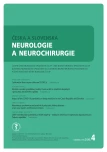Current diagnostics of secondary progressive form of multiple sclerosis and its treatment with siponimod
Authors:
P. Štourač
Authors place of work:
Neurologická klinika LF MU a FN Brno
Published in the journal:
Cesk Slov Neurol N 2020; 83/116(4): 364-367
Category:
Přehledný referát
doi:
https://doi.org/10.14735/amcsnn2020364
Summary
Multiple sclerosis is a chronic inflammatory disease of the CNS. Secondary progressive MS is the second most common form of MS worldwide and symptomatic treatment is currently the only available option in the Czech Republic. Neurodegeneration and less inflammatory processes are the main pathophysiological processes underlying the transition to the secondary progressive phase of MS. Because of clinical diagnostic obstacles, the diagnosis of secondary progressive MS is often postponed by 3 years. Diagnostic criteria based on the data from MSBase registry enable the elimination of this diagnostic gap. Siponimod is the first oral drug for the treatment of secondary progressive MS with clinical or MRI activity reducing the disability progression or selected MRI parameters. The efficacy and safety of siponimod were tested in the phase III clinical trial EXPAND. The most suitable criteria for treatment with siponimod and its safety profile including possibilities in the case of treatment failure are under scrutiny of the scientific neurological society in the Czech Republic.
Keywords:
diagnosis – treatment – secondary progressive multiple sclerosis – siponimod
Zdroje
1. Multiple Sclerosis International Federation (MSIF) Atlas of MS 2013. [online]. Available from URL: https: // www.msif.org/wp-content/uploads/2014//09/Atlas-of - MS.pdf.
2. Khurana V, Sharma H, Medin J et al. Estimated prevalence of diagnosed secondary progressive multiple sclerosis in the Americas and Europe: results from a systematic literature search. Neurology 2018; 90 (15 Suppl): P2.380.
3. Scalfari A, Neuhaus A, Daumner M et al. Onset of secondary progressive phase and long-term evolution of multiple sclerosis. J Neurol Neurosurg Psychiatry 2014; 85 (1): 67–75. doi: 10.1136/jnnp-2012-304333.
4. Cree BA, Gourraud PA, Oksenberg JR et al. Long - -term evolution of multiple sclerosis disability in the treatment era. Ann Neurol 2016; 80 (4): 499–510. doi: 10.1002/ana.24747.
5. Coret F, Perez-Miralles FC, Gascon F et al. Onset of secondary progressive multiple sclerosis is not influenced by current relapsing multiple sclerosis therapies. Mult Scler J Exp Transl Clin 2018; 4 (2): 2055217318783347. doi: 10.1177/2055217318783347.
6. Lorscheider J, Buzzard K, Jokubaitis et al. Defining secondary progressive multiple sclerosis. Brain J Neurol 2016; 139 (9): 2395–2405. doi: 10.1093/brain/aww173.
7. Katz Sand I, Krieger S, Faqrrell C et al. Diagnostic uncertainity during the transition to secondary progressive multiple sclerosis. Mult Scler 2014; 20 (12): 1654–1657. doi: 10.1177/1352458514521517.
8. Inojosa H, Proschmann U, Akgun K et al. A focus on secondary progressive multiple sclerosis (SPMS): challenges in diagnosis and definition. J Neurol 2019; [ahead of print]. doi: 10.1007/s00415-019-09489-5.
9. Goodman D, Anadani N, Gerwitz L. Siponimod in the treatment of multiple sclerosis. Expert Opin Investig Drugs 2019; 28 (15): 1051–1057. doi: 10.1080/13543784. 2019.1676725.
10. Brinkman V. FTY 20 (fingolimod) in multiple sclerosis: therapeutic effect in the immune and the central nervous system. Br J Pharmacol 2009; 158 (5): 1173–1182. doi: 10.1111/j.1476-5381.2009.00451.x.
11. Gentile A, Musella A, Bullita S et al. Siponimod (BAF 312) prevents synaptic neurodegeneration in experimetal multiple sclerosis. J Neuroinflammation 2016; 13 (1): 207. doi: 10.1186/s12974-016-0686-4.
12. Kappos L, Bar-Or A, Cree B, et al. Siponimod versus placebo in secondary progressive multiple sclerosis (EXPAND): a double-blind, randomised, phase 3 study. Lancet 2018; 391 (10127): 1263–1273. doi: 10.1016/S0140-6736 (18) 30475-6.
13. Mayzent. Souhrn údajů o přípravku. [online]. Dostupné z URL: https: //www.ema.europa.eu/en/documents/product-information/mayzent-epar-product-information_cs.pdf.
14. SÚKL. Státní ústav pro kontrolu léčiv. Gilenya – Souhrn údajů o přípravku. [online]. Dostupné z URL: http: //www.sukl.cz/modules/medication/detail.php?code=0168462&tab=texts.
Štítky
Dětská neurologie Neurochirurgie NeurologieČlánek vyšel v časopise
Česká a slovenská neurologie a neurochirurgie

2020 Číslo 4
- Metamizol jako analgetikum první volby: kdy, pro koho, jak a proč?
- Zolpidem může mít širší spektrum účinků, než jsme se doposud domnívali, a mnohdy i překvapivé
- Jak souvisí postcovidový syndrom s poškozením mozku?
- Nejčastější nežádoucí účinky venlafaxinu během terapie odeznívají
- Dávkování a správná titrace dávky pregabalinu
Nejčtenější v tomto čísle
- Je jasné, kdy operovat výhřez bederní meziobratlové ploténky?
- CGRP monoklonální protilátky v léčbě migrény – indikační kritéria a terapeutická doporučení pro Českou republiku
- Cytotoxické léze corpus callosum (CLOCCs)
- Dropped head syndrom u pacientky s progredující bulbární paralýzou
